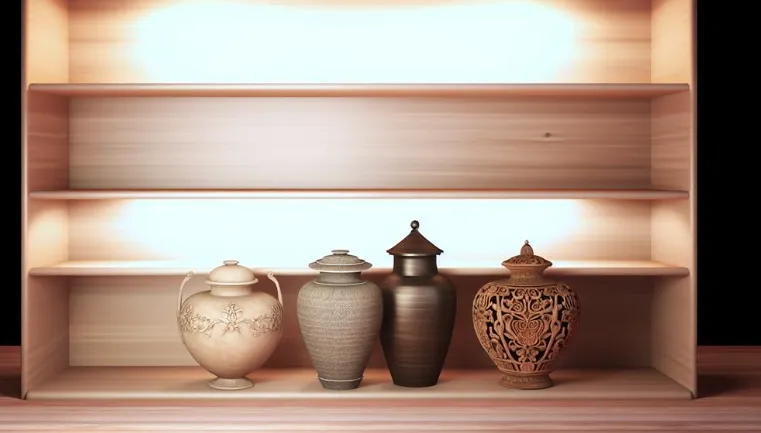Finding the Perfect Urn: A Comprehensive Selection for Your Needs

Did you know that the material of the urn you choose can significantly affect how it weathers over time if kept outdoors? You’re not just selecting a container; you’re choosing a permanent home that reflects the essence of your loved one. Whether it’s the classic dignity of marble, the warm sheen of wood, or the modern sleekness of ceramic, each material speaks to different aspects of memory and legacy. As you consider your options, think about where the urn will be placed and what personal touches might honor the unique life it commemorates. What factors will guide your choice?
Contents
Understanding Urn Materials
When choosing urns, it’s essential to consider the variety of materials available, each offering distinct qualities and aesthetics. The durability of the material is a primary concern, as you’ll want something that maintains its integrity and appearance over time. Metals like bronze and brass are popular for their robustness and ability to withstand the elements, making them suitable for both indoor and outdoor placements. Ceramics, while more fragile, offer a classic elegance that many find comforting.
You should also weigh the environmental impact of your choice. Biodegradable materials such as paper, salt, or even sand are becoming more prevalent. These eco-friendly options dissolve naturally when buried or placed in water, making them a thoughtful choice for those mindful of their ecological footprint.
On the other hand, materials like stone and marble, though durable, require significant energy for extraction and shaping, which can contribute to environmental degradation. It’s crucial to balance your personal preferences with these broader impacts, ensuring your choice aligns with your values and the legacy you wish to leave behind. This attention to both material durability and environmental considerations will guide you in selecting an urn that honors your loved one respectfully and responsibly.
Choosing the Right Size
Choosing the right size for an urn is crucial as it must appropriately accommodate the ashes of your loved one. The process involves careful capacity calculation to ensure the urn you select is neither too large nor too small. Generally, the rule of thumb is that one pound of pre-cremation body weight corresponds to approximately one cubic inch of space. Therefore, if your loved one weighed 150 pounds, you’d look for an urn that offers at least 150 cubic inches of space.
Space planning also plays a vital role when selecting an urn. Consider where the urn will be placed — whether it will be displayed in your home, stored in a columbarium niche, or buried. Each location may require different urn sizes and shapes. For instance, niches in columbaria have specific dimensions; thus, you’ll need to confirm these details to ensure a proper fit.
It’s important to understand these parameters as they directly impact your selection process. By integrating both capacity calculation and space planning into your decision, you’ll find an urn that not only beautifully honors the memory of your loved one but also fits seamlessly into its intended space.
Exploring Design Styles
After selecting the right size, you’ll want to consider the various design styles available to find an urn that reflects your loved one’s personality and aesthetics. The diversity in urn designs is vast, ranging from simple and understated to ornate and intricate. Understanding the influence of different cultures and historical eras can guide you in making a choice that honors your loved one’s unique life and values.
Cultural influences play a significant role in urn design. For instance, Asian-inspired urns may feature cherry blossoms or dragons, symbols of beauty and strength in many Eastern cultures. Alternatively, urns with Celtic knots or Gaelic patterns reflect Irish or Scottish heritage, embodying a connection to those ancient traditions.
Era trends also impact urn styles significantly. Art Deco urns, with their streamlined geometric forms and rich colors, mirror the opulence of the early 20th century, while Victorian-style urns might be adorned with elaborate floral patterns and soft, curved lines, echoing the romantic sensibilities of the 19th century.
When choosing an urn, think about the designs that might’ve appealed to your loved one or that represent their era or culture. This thoughtful consideration ensures the urn isn’t just a resting place but a meaningful tribute to their life and legacy.
Personalization Options
Personalizing an urn allows you to capture the essence of your loved one’s spirit and individuality through unique engravings, images, or inscriptions. Different engraving techniques can reflect the depth of your memories and the complexity of their personality. For instance, laser engraving offers precise and intricate designs, allowing you to include detailed images or elaborate text that resonates with personal stories or important dates.
Color customization also plays a pivotal role in personalizing an urn. You can choose colors that were meaningful to your loved one or that evoke a particular emotion or memory. This could range from soft, soothing pastels to vibrant, energetic hues, depending on what best commemorates their life and spirit.
When selecting personalization options, it’s crucial to consider how these elements blend together to create a harmonious and fitting tribute. Think about the interplay of colors with the chosen engravings—how they highlight or complement each other. A professionally customized urn not only serves as a resting place but also as a profound and beautiful reminder of a unique life lived. Each detail contributes to making the urn a deeply personal and cherished memorial.
Budget Considerations
While exploring personalization options, it’s important to also consider your budget as costs can vary significantly based on the choices you make. The price of urns can range from modest to substantial, depending on materials, design, and customization features. It’s wise to perform cost comparisons between different types and styles to find an option that meets both your aesthetic preferences and financial constraints.
Materials like ceramic, wood, or biodegradable options tend to be more affordable, while metals such as bronze or copper might increase the price. Additionally, intricate designs or custom engravings can add to the cost. You’ll want to balance your desire for a unique tribute with the practicalities of your budget.
For those finding the costs a bit steep, alternative financing options may be available. Some providers offer payment plans that break down the total cost into manageable monthly payments. Alternatively, exploring discounts or choosing simpler designs can also help in keeping expenses within your budget.


